battery Peugeot 508 RXH 2013 Owner's Manual
[x] Cancel search | Manufacturer: PEUGEOT, Model Year: 2013, Model line: 508 RXH, Model: Peugeot 508 RXH 2013Pages: 308, PDF Size: 8.95 MB
Page 4 of 308

.
.
Contents
Instrument panel 49
Indicator and warning lamps 50
Gauges and indicators 61
Tr ip computer 66
Setting the date and time 69
Instruments and controlsFamiliarisation
Remote control key 70
Alarm 80
Electric windows 82
Boot 84
Motorised tailgate 85
Panoramic sunroof 88
Fuel tank 89
Diesel misfuel prevention 90
Access
Front seats 92
Rear seats 96
Mirrors 98
Steering wheel adjustment 100
Interior fi ttings 101
Boot fi ttings 104
Heating and Ventilation 110
Dual-zone digital air conditioning 112
Quad-zone digital air conditioning 115
Rear screen demist - defrost 120
Programmable Heating / Ventilation 121
Comfort
Electric parking brake 123
6-speed electronic gearbox 130
Hill star t assist 134
Head-up display 135
Speed limiter 138
Cruise control 140
Parking sensors 142
Parking space sensors 144
Driving
Lighting controls 146
LED lamps 149
Automatic illumination of headlamps 151
Headlamp adjustment 154
Directional lighting 155
Wiper controls 156
Automatic rain sensitive wipers 158
Cour tesy lamps 160
Interior mood lighting 161
Visibility Hybrid system
Presentation 22
Starting / switching off 25
Ready lamp 29
HYbrid4 mode selector 29
Energy consumption / generation
indicator 32
Display of hybrid power fl ow 33
HYbrid4 frequently asked questions 36
Eco off 39
Eco-driving 40
Consumption 42
High voltage battery 43
Car washing machine or tunnel 47
Vehicle recovery 48
Page 5 of 308
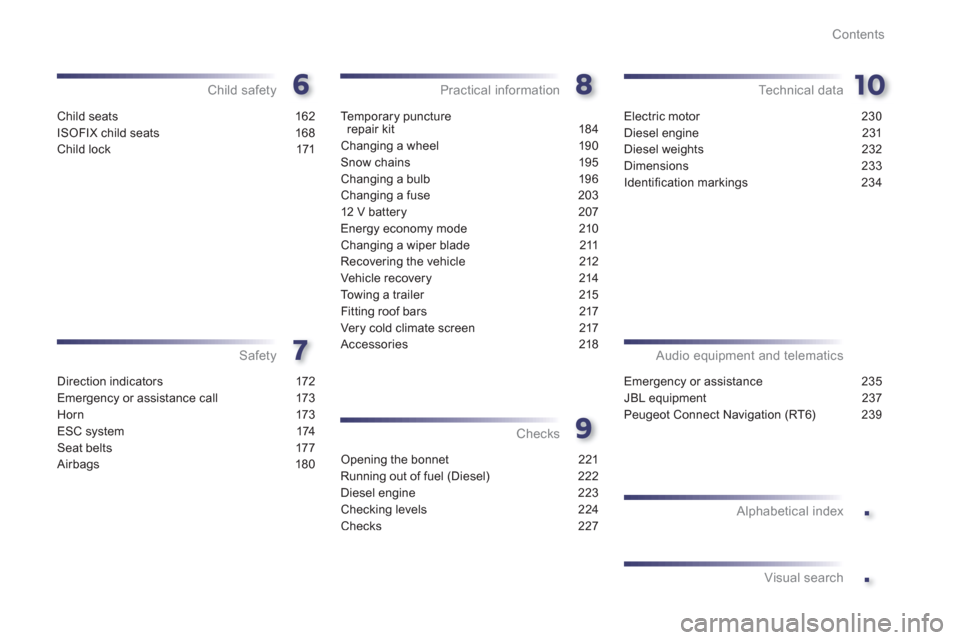
.
.
Contents
Child seats 162
ISOFIX child seats 168
Child lock 171
Child safety
Direction indicators 172
Emergency or assistance call 173
Horn 173
ESC system 174
Seat belts 177
Airbags 180
Safety
Te m p o r a ry puncture
repair kit 184
Changing a wheel 190
Snow chains 195
Changing a bulb 196
Changing a fuse 203
12 V battery 207
Energy economy mode 210
Changing a wiper blade 211
Recovering the vehicle 212
Vehicle recovery 214
Towing a trailer 215
Fitting roof bars 217
Very cold climate screen 217
Accessories 218
Practical information
Opening the bonnet 221
Running out of fuel (Diesel) 222
Diesel engine 223
Checking levels 224
Checks 227
Checks
Electric motor 230
Diesel engine 231
Diesel weights 232
Dimensions 233
Identifi cation markings 234
Technical data
Emergency or assistance 235
JBL equipment 237
Peugeot Connect Navigation (RT6) 239
Audio equipment and telematics
Alphabetical index
Visual search
Page 6 of 308
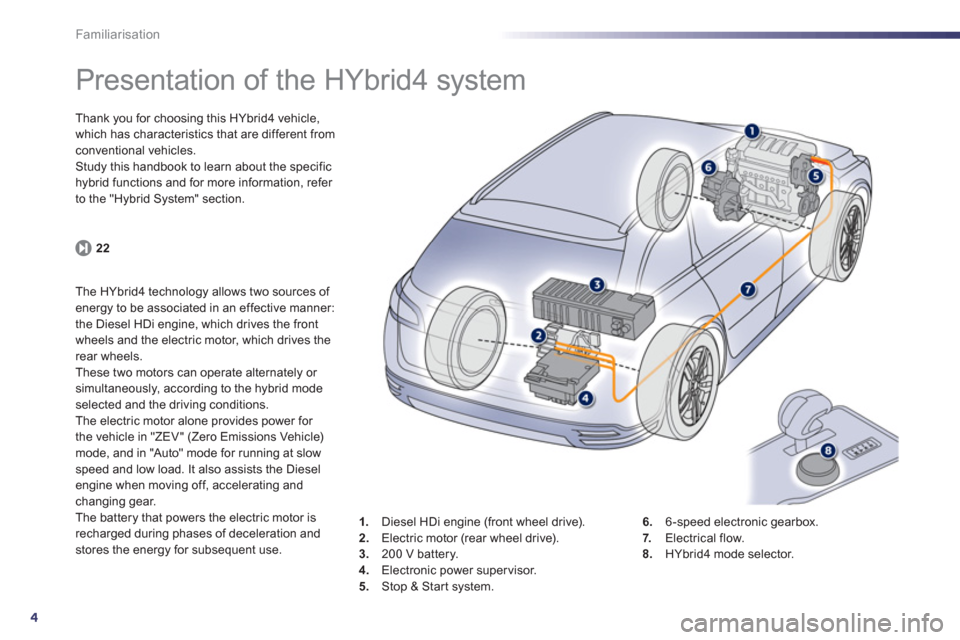
4
Familiarisation
Presentation of the HYbrid4 system
Thank you for choosing this HYbrid4 vehicle,
which has characteristics that are different from conventional vehicles.
Study this handbook to learn about the specific hybrid functions and for more information, refer
to the "Hybrid System" section.
22
The HYbrid4 technology allows two sources of energy to be associated in an effective manner:
the Diesel HDi engine, which drives the front
wheels and the electric motor, which drives the
rear wheels.
These two motors can operate alternately or simultaneously, according to the hybrid modeselected and the driving conditions.
The electric motor alone provides power for
the vehicle in "ZEV" (Zero Emissions Vehicle) mode, and in "Auto" mode for running at slowspeed and low load. It also assists the Dieselengine when moving off, accelerating and changing gear.
The battery that powers the electric motor is
recharged during phases of deceleration andstores the energy for subsequent use.1
.Diesel HDi engine (front wheel drive). 2. Electric motor (rear wheel drive).3.
200 V battery.4.Electronic power supervisor.
5.Stop & Start system. 6
.6 -speed electronic gearbox.7. Electrical flow. 8.HYbrid4 mode selector.
Page 24 of 308
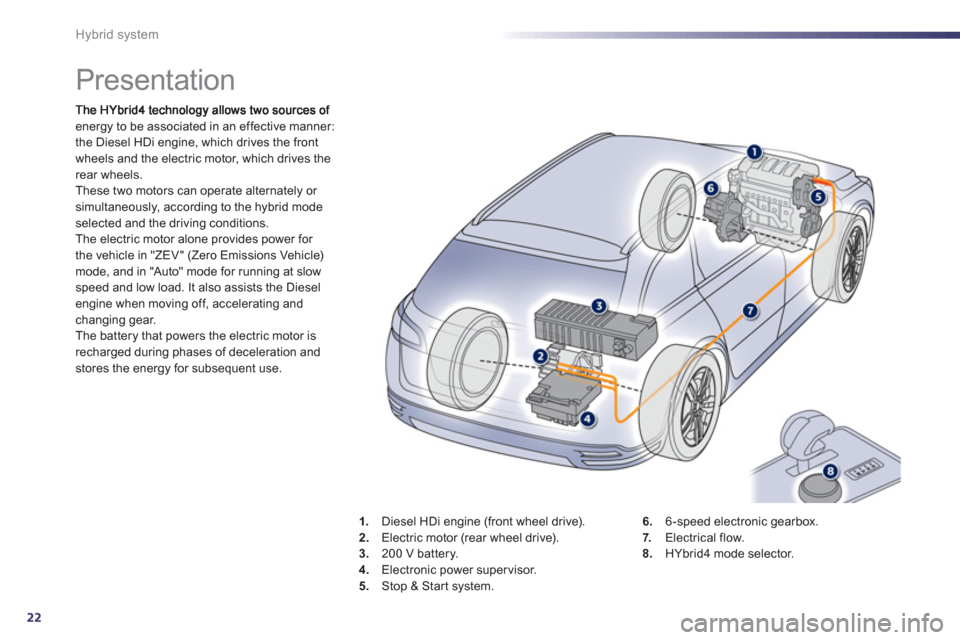
22
Hybrid system
Presentation
energy to be associated in an effective manner:
the Diesel HDi engine, which drives the front
wheels and the electric motor, which drives the rear wheels.These two motors can operate alternately or simultaneously, according to the hybrid modeselected and the driving conditions.
The electric motor alone provides power for
the vehicle in "ZEV" (Zero Emissions Vehicle) mode, and in "Auto" mode for running at slowspeed and low load. It also assists the Dieselengine when moving off, accelerating and changing gear.The battery that powers the electric motor is recharged during phases of deceleration andstores the energy for subsequent use.
1.Diesel HDi engine (front wheel drive). 2. Electric motor (rear wheel drive).3.
200 V battery.4.Electronic power supervisor.
5
.Stop & Start system. 6
.6 -speed electronic gearbox.7. Electrical flow. 8.HYbrid4 mode selector.
Page 25 of 308
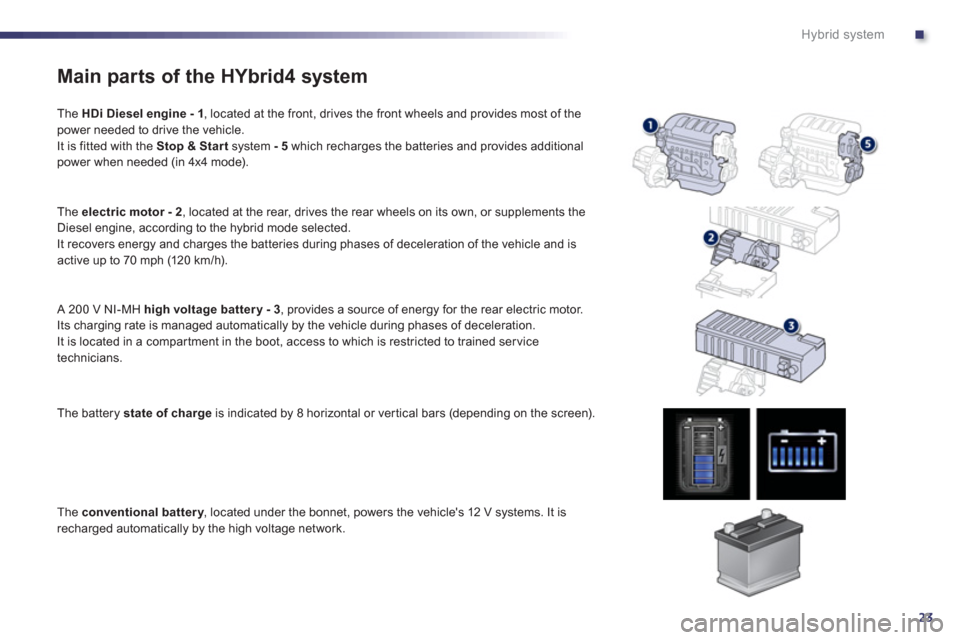
.
23
Hybrid system
Main parts of the HYbrid4 system
The HDi Diesel engine - 1
, located at the front, drives the front wheels and provides most of the power needed to drive the vehicle.
It is fitted with the Stop & Start
system - 5
which recharges the batteries and provides additional
power when needed (in 4x4 mode).
Th
e electric motor - 2
, located at the rear, drives the rear wheels on its own, or supplements the
Diesel engine, according to the hybrid mode selected.
It recovers energy and charges the batteries during phases of deceleration of the vehicle and is
active up to 70 mph (120 km / h).
A 200 V NI-MH high voltage battery - 3
, provides a source of energy for the rear electric motor.
Its charging rate is managed automatically by the vehicle during phases of deceleration.
It is located in a compar tment in the boot, access to which is restricted to trained service
technicians.
The batter
y state of chargeis indicated by 8 horizontal or vertical bars (depending on the screen).
The conventional battery, located under the bonnet, powers the vehicle's 12 V systems. It is yrecharged automatically by the high voltage network.
Page 26 of 308
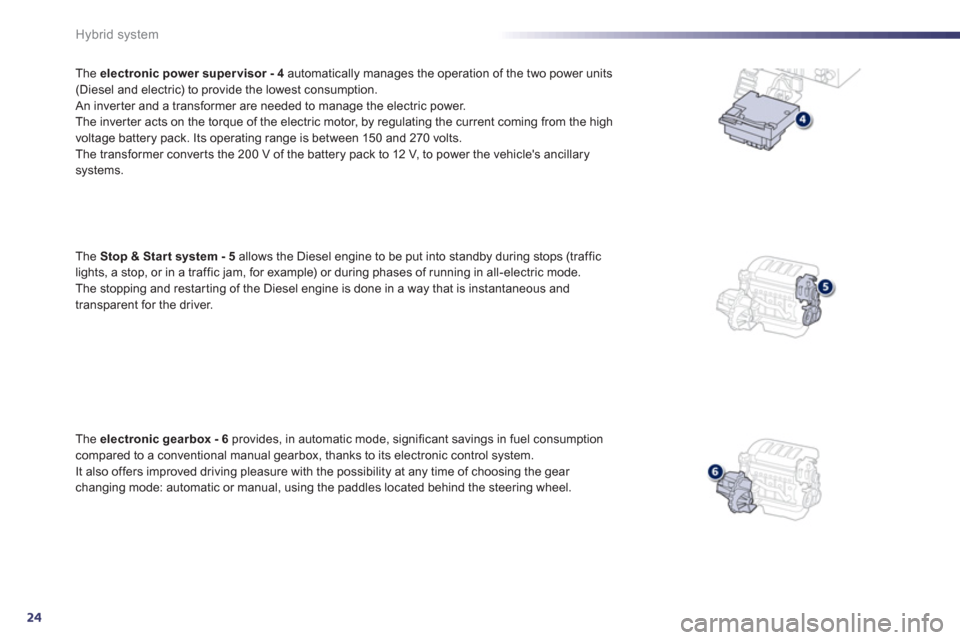
24
Hybrid system
The electronic power super visor - 4automatically manages the operation of the two power units(Diesel and electric) to provide the lowest consumption.
An inver ter and a transformer are needed to manage the electric power.
The inver ter acts on the torque of the electric motor, by regulating the current coming from the high
voltage battery pack. Its operating range is between 150 and 270 volts.
The trans
former conver ts the 200 V of the battery pack to 12 V, to power the vehicle's ancillary
systems.
Th
e Stop & Star t system - 5
allows the Diesel engine to be put into standby during stops (traffic
lights, a stop, or in a traffic jam, for example) or during phases of running in all-electric mode.
The stopping and restar ting of the Diesel engine is done in a way that is instantaneous and
transparent for the driver.
Th
e electronic gearbox - 6provides, in automatic mode, significant savings in fuel consumption compared to a conventional manual gearbox, thanks to its electronic control system.
It also offers improved driving pleasure with the possibility at any time of choosing the gear changing mode: automatic or manual, using the paddles located behind the steering wheel.
Page 29 of 308
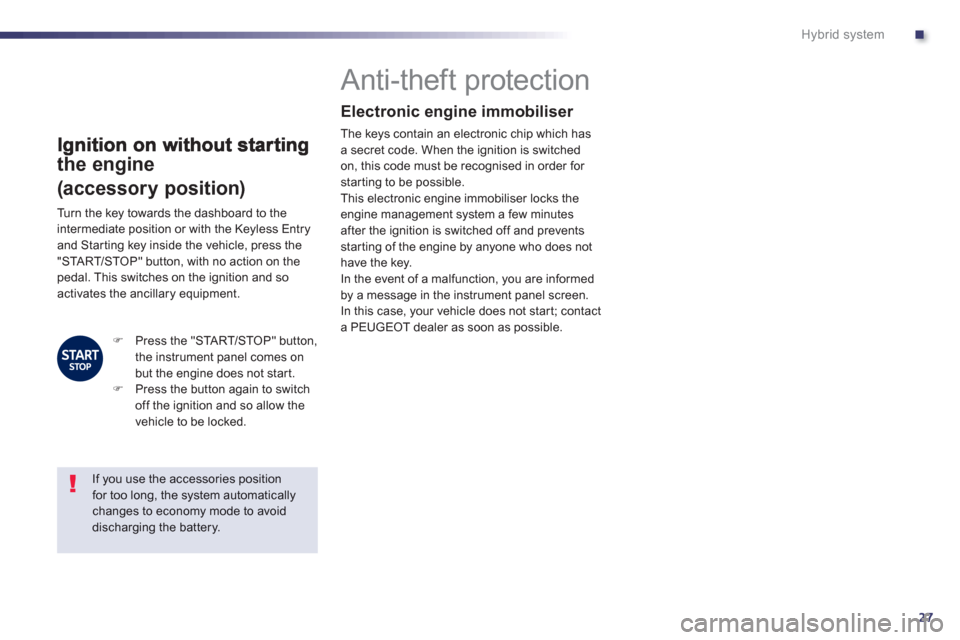
.
27
Hybrid system
the engine
(accessory position)
Anti-theft protection
Electronic engine immobiliser
The keys contain an electronic chip which hasa secret code. When the ignition is switched
on, this code must be recognised in order for
starting to be possible.
This electronic engine immobiliser locks the
en
gine management system a few minutes after the ignition is switched off and prevents
starting of the engine by anyone who does not have the key.
In the event of a malfunction, you are informed by a message in the instrument panel screen.In this case, your vehicle does not start; contacta PEUGEOT dealer as soon as possible.
Turn the key towards the dashboard to the
intermediate position or with the Keyless Entry
and
Starting key inside the vehicle, press the
"START/STOP" button, with no action on the pedal. This switches on the ignition and so
activates the ancillary equipment.
�)Press the "STA R T/STOP" button,
the instrument panel comes on
but the en
gine does not star t. �)Press the button again to switch
off the ignition and so allow the
vehicle to be locked.
If you use the accessories positionfor too long, the system automaticallychanges to economy mode to avoid discharging the battery.
Page 32 of 308
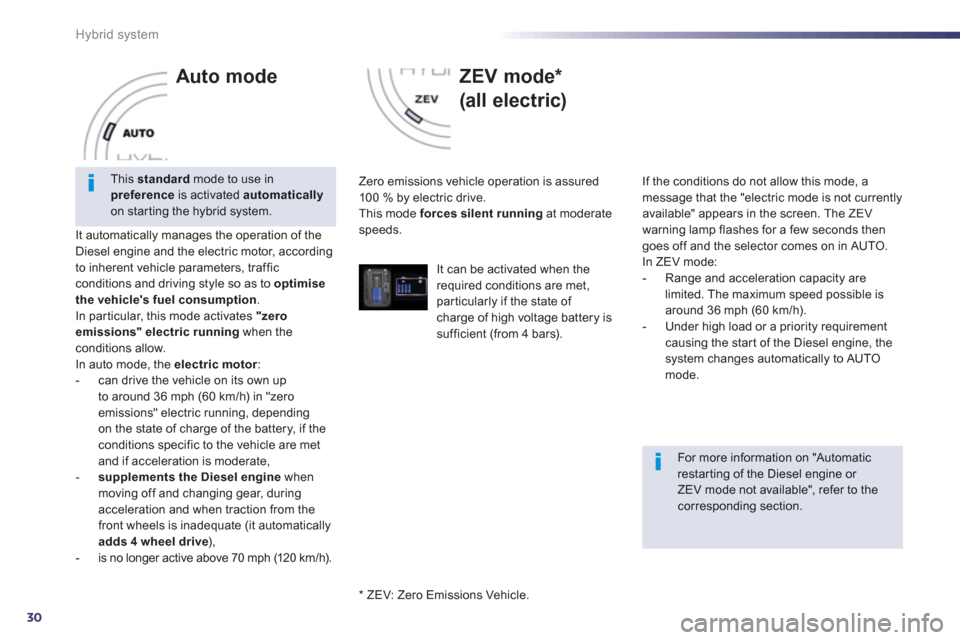
30
Hybrid system
Auto mode
It automatically manages the operation of the
Diesel engine and the electric motor, according
to inherent vehicle parameters, traffic
conditions and driving style so as to optimise
the vehicle's fuel consumption.In par ticular, this mode activates "zero emissions" electric runningwhen theconditions allow.
In auto mode, the electric motor
:
- can drive the vehicle on its own up
to around 36 mph
(60 km/h) in "zero
emissions" electric running, dependingon the state of charge of the battery, if the conditions specific to the vehicle are metand if acceleration is moderate, -supplements the Diesel enginewhen moving off and changing gear, during acceleration and when traction from thefront wheels is inadequate (it automaticallyadds4 wheel drive ),
- is no longer active above 70 mph (120 km / h).
ZEV mode *
(all electric)
Zero emissions vehicle operation is assured
10 0 % by electric drive.
This mode forces silent runningat moderatespeeds.
If the conditions do not allow this mode
, amessage that the "electric mode is not currentlyavailable" appears in the screen. The ZEV
warning lamp flashes for a few seconds then
goes off and the selector comes on in AUTO.
In ZEV mode:
- Range and acceleration capacity are
limited. The maximum speed possible is
around 36 mph (60 km/h).
- Under high load or a priority requirement causing the star t of the Diesel engine, thesystem changes automatically to AUTO mode.
This standard
mode to use inpreferenceis activated automaticallyon star ting the hybrid system.
For more information on "Automaticrestarting of the Diesel engine or ZEV mode not available", refer to the corresponding section.
*
ZEV: Z
ero Emissions Vehicle.
It can be activated when therequired conditions are met, particularly if the state of charge of high voltage battery is sufficient (from 4 bars).
Page 33 of 308
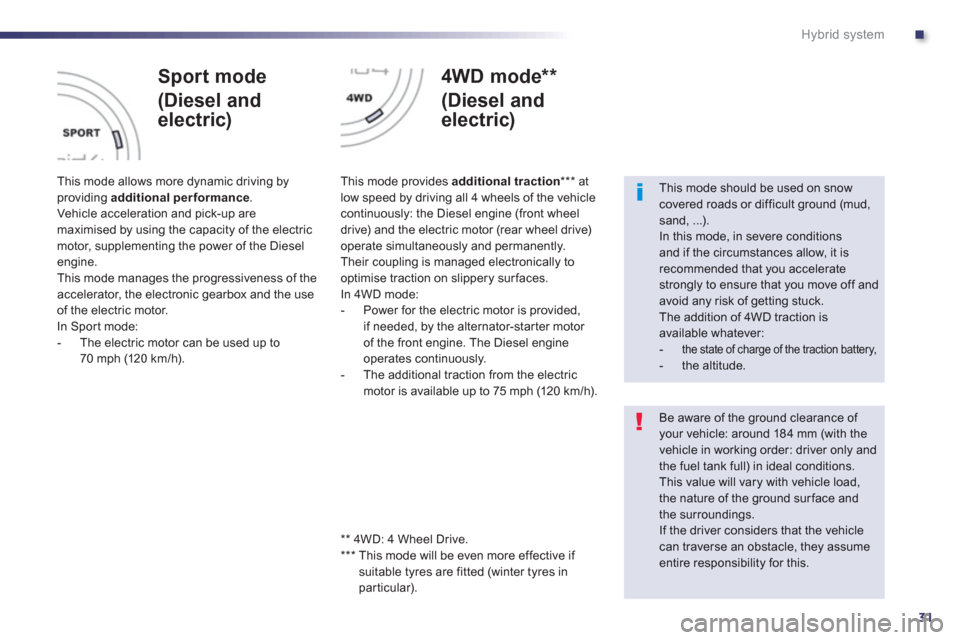
.
31
Hybrid system
Sport mode
(Diesel and
electric)
This mode allows more dynamic driving byproviding additional performance. Vehicle acceleration and pick-up aremaximised by using the capacity of the electricmotor, supplementing the power of the Dieselengine.
This mode manages the progressiveness of the
accelerator, the electronic gearbox and the useof the electric motor.
In Spor t mode:
-
The electric motor can be used up to
70 mph (120 km/h).
4WD mode **
(Diesel and
electric)
This mode provides additional traction*** at low speed by driving all 4 wheels of the vehiclecontinuously: the Diesel engine (front wheel
drive) and the electric motor (rear wheel drive)
operate simultaneously and permanently.
Their couplin
g is managed electronically to
optimise traction on slippery surfaces.
In 4WD mode:
- Power for the electric motor is provided,
if needed, b
y the alternator-star ter motor
of the front engine. The Diesel engine
operates continuously.
- The additional traction from the electric
motor is available up to 75 mph (120 km/h).
This mode should be used on snow covered roads or difficult ground (mud,sand, ...).
In this mode, in severe conditions and if the circumstances allow, it is recommended that you accelerate strongly to ensure that you move off and avoid any risk of getting stuck.
The addition of 4WD traction isavailable whatever:
- the state of charge of the traction battery,
- the altitude.
Be aware of the ground clearance of your vehicle: around 184 mm (with the vehicle in working order: driver only and the fuel tank full) in ideal conditions.
This value will vary with vehicle load,the nature of the ground surface and the surroundings.
If the driver considers that the vehicle
can traverse an obstacle, they assumeentire responsibility for this.
**
4WD: 4 Wheel Drive.
***
This mode will be even more effective if suitable tyres are fitted (winter tyres in
particular
).
Page 34 of 308
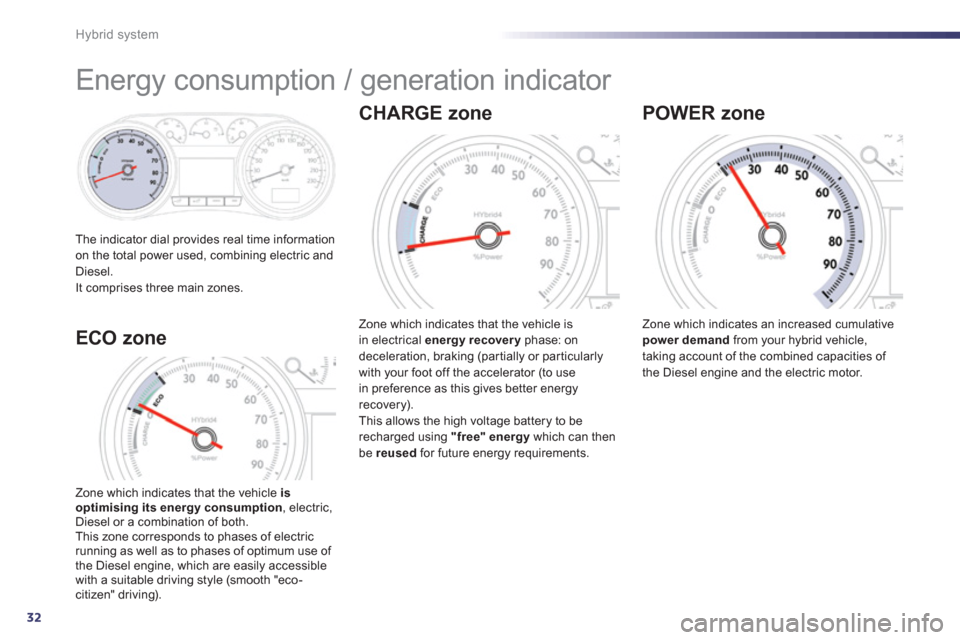
32
Hybrid system
Energy consumption / generation indicator
The indicator dial provides real time information
on the total power used, combining electric and
Di
esel.
It comprises three main zones.
CHARGE zone
Zone which indicates that the vehicle isin electrical energy recovery
phase: on
deceleration, braking (partially or par ticularlywith your foot off the accelerator (to use
in preference as this gives better energy recovery).
This allows the high voltage battery to be recharged using "free" energy
which can thenbe reusedfor future energy requirements.
POWER zone
Zone which indicates an increased cumulative power demand
from your hybrid vehicle,
taking account of the combined capacities of
the Diesel engine and the electric motor.
Zone which indicates that the vehicle is
optimising its energy consumption, electric,
Diesel or a combination of both.
This zone corresponds to phases of electric
running as well as to phases of optimum use of
the Diesel engine, which are easily accessible
with a suitable driving style (smooth "eco-citizen" driving).
ECO zone